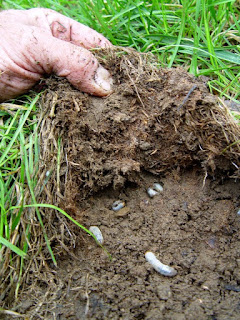 |
| One Lone, Late Season Japanese Beetle on Gaura |
Mid-summer I found a new organic product for adult beetles called beetleJUS!™. It turned out to be very effective. In just a day or two after spraying I found dead beetles in the area and noticed fewer numbers on my plants. There is a grub control containing the same organic microbiol in beetleJUS!™ see below for additional information.
To recap from my first blog - Japanese beetles have a one-year life cycle. They emerge as adults sometime in June and immediately spend their next 6-8 weeks as adults ruining your favorite plants. Females take time out from feeding to lay eggs in your grass. A garden friend told me that she had seen them actually dive bomb into the turf to deposit eggs. The adults die off in late summer, but the larvae grow and live in turf areas until next summer to start the wrath all over again. I sort of compare JBs to annual sunflowers (which we like in our gardens) where the end of the season sunflower seeds (eggs in the case of the JBs) are dropped (laid) for next summer's enjoyment (bane).
 |
| Photo from the University of Arkansas Turfgrass Science |
 |
| Photo from strawhatlawnguy.com |
Below is a list of larvae control options. My recommendation would be to select the most environmentally friendly product so that any beneficial insects in your garden are not negatively affected. Please choose control products wisely and consider what works best for you, your budget and time. I've compiled this list from credible, research-based websites and professionals in the green industry. Please do your own homework beyond what is written here.
Controls for Japanese Beetle egg/larvae in turf areas
Bacillus thuringiensis (Bt)
Bacillus thuringiensis (Bt)
beetleJUS!™
Because the adult beetles are very mobile, use of products on your lawn may have little affect in controlling the number of beetles from year to year if lawns around you are not also treated.
Biological (Organic) Controls:
1. Milky Spore (Bacillus popilliae), a bacterium that produces ‘milky disease’ in Japanese beetle grubs. (sold under the trade name St. Gabriels’ Organics Milky Spore Powder.) Read more - Alternatives to Insecticides
2. Nematodes (small round worms that kill grubs) in the genus Heterorhabditis (e.g., Heterorhabditis bacteriophora, H. megadis). Use as a soil drench during cool weather, must be watered in and applied when beetle larvae are present. Read more - Insect Parasitic Nematodes
3. Brand new to the garden market is organic GrubHALT!™ which is a Bacillus thuringiensis product. Bt is a microbiol insecticide and when ingested paralyses the digestive system so the insect pest stops feeding and dies within a few days. The newest strain is called Bacillus thuringiensis galleriae or Btg.
The upside to Btg is that it is safe to use around beneficial insects including bees, butterflies, lady beetles and people, pets and wildlife. It is also effective to use on all stages of larval growth. Other products may only work on the youngest larvae (1st-instar). This product is not sold in garden centers - mail order from Gardens Alive. Btg is currently, as of this writing, early September 2015, getting registered in the state of Colorado. Upon approval Btg will be available from other resources, see - grubGONE!®.
Use of organic products in the garden does not necessarily mean they are without unintended consequences to beneficial insects, people, pets, birds or fish. ALWAYS read the label for caution information, mixing rates and time of use.
Chemical Controls:
2. Imidacloprid* trade names - Merit, Zenith, Criterion, also found in Bayer and Hi-Yield Products and more.
Additional Resources:
Japanese Beetles from Colorado State University
Billbugs and White Grubs from Colorado State University
United States Department of Agriculture Managing the Japanese Beetle: A Homeowner's Handbook
No comments:
Post a Comment
Note: Only a member of this blog may post a comment.